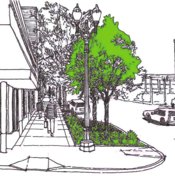
streetscape on Burnside.
Portland Mayor Sam Adams and a host of dignitaries and bureaucrats held a groundbreaking ceremony for the East Burnside-Couch couplet project yesterday. The $17.8 million project will transform the streetscape of Burnside and Couch by turning them into one-ways, adding traffic signals, bike lanes, trees, curb extensions, and more.
The City is doing the project for several reasons: They hope it will trigger development, improve safety and traffic flow, enhance the business environmen, and in the end, make Burnside into a kinder, gentler street.
Yesterday I sat down with City of Portland Bureau of Transportation project managers Bill Hoffman and Chris Armes to learn more about how people on bikes will navigate through the couplet.
The big changes are on Burnside and Couch, but SE Ankeny — a popular east-west bike route — also figured into this project’s plans.

Currently, Burnside has six (and sometimes seven) lanes of two-way traffic with on-street parking available at off-peak hours. When the couplet project is complete, on-street parking will be allowed at all times on both sides of the streets and Burnside will be re-striped for four vehicles lanes — with one of them dedicated to bike traffic. The new, bike-only traffic lane (a.k.a. a bike lane) on Burnside will run from MLK to NE 13th.
On NE Couch, PBOT will stripe a new bike lane starting at NE 6th that will continue west all the way onto the Burnside Bridge. To get to Couch from Ankeny, PBOT will direct riders north on NE 6th (to Couch) where the bike lane begins. (All the bike lanes in the project are the standard 5-6 feet wide.)
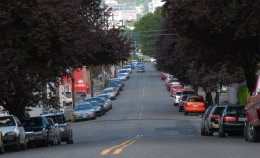
(Photo © J. Maus)
Asked why they chose to not stripe the bike lane all the way up Couch to 12th (which is an important north-south connector to get through the Lloyd Center), Hoffman gave two reasons. First, he said their planning process was not focused on Couch. “It was all about how to get cyclists from Ankeny onto the bridge.” As for Couch, he said “You could have had a bike lane all the way up Couch, but that would have impacted the ability to have on-street bike parking and the green curb extensions on one side.”
“The challenge then became, how best to accomodate both needs. All the designs we considered had some amount of trade-off and this appeared to be the best solution.”
“There was absolute consideration and respect for bikes in this project. The challenge is getting all of these functions to work in limited right of way.”
— Bill Hoffman, PBOT project manager
Finding space for a bike lane on Couch was a challenge for project planners. In our meeting yesterday, Hoffman said business owners in the area were opposed to removing any parking at all (his exact words were that they saw any on-street parking removal as “the third rail” which I’ve since learned means it was a non-starter).
Stakeholders and planners couldn’t reach a consensus on how to fit the bike lane in on Couch, so Mayor Adams (who was Commissioner in charge of transportation at the time) stepped in to make the decision. Ultimately, the decision was made to make room for the bike lane by narrowing the sidewalk from 12 to 7 feet.
On-street motor vehicle parking still holds a large amount of sway in PBOT projects. When room exists for everything to fit — like on Burnside — it’s easy for the City to put in a bike lane (and they’re happy to do it). But when the right-of-way is at all constrained, PBOT will very rarely remove significant amounts of on-street parking to make room for the efficient and safe flow of non-motorized traffic.
Asked about why this couplet project retained so much on-street parking capacity, Hoffman said it’s about trade-offs. “There was absolute consideration and respect for bikes in this project. The challenge is getting all of these functions to work in limited right of way… The trade-offs for a bike lane the full length of Couch were much more significant.”
It’s also worth noting that since Couch has a downhill grade, bike traffic should be able to comfortably take the lane with motor vehicle traffic (currently, there are no plans to install shared-lane markings).
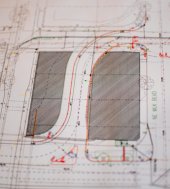
Once on the new Couch bike lane headed west, you’ll cross over Grand and MLK. Just west of MLK will be a new street segment project planners are calling the “Couch Transition”. This street will go across the now-vacant parcel bordered by NE 3rd, Couch and MLK and take traffic onto the Burnside Bridge.
Along with new bike lanes on Couch and Burnside, PBOT will add curb extensions with green stormwater treatments and new signals to every intersection on Burnside. These new signals will have a major traffic impact. Hoffman said the signals will play a large role in “humanizing” the street because they’ll be timed at a reasonable speed. “Because the signals will be timed to 15 mph, you’ll have cars platooning at a modest speed.”
Hoffman and fellow project manager Chris Armes said yesterday they expect bike traffic to increase once the project is complete. PBOT staffers have already done bike traffic surveys to gauge existing conditions and they’ll do follow-up surveys once it’s finished to find out if that holds true.
Another area of this project that will impact people traveling by bike is the notorious intersection of NE Sandy Blvd, Burnside and NE 12th. At that location, PBOT plans to decommission the segment of Sandy just north of Burnside between NE 12th and 14th.
In a statement issued by Mayor Adams after the groundbreaking event, he said this closure of Sandy will “transform the intersection… providing an eastern “gateway to the lower Burnside district, and moving traffic efficiently through what has been called the worst intersection in Portland.”
Adams has a lot riding on this project. “Its a signature project for the Mayor,” says his Transportation Policy Director Catherine Ciarlo. The couplet’s “green street” features (lots of new trees and bioswales to catch and filter stormwater in the curb extensions), expectations of urban renewal, bike lanes, and speed controlling features are all things that Adams has championed throughout his political career.
The success of this couplet on the east side, could also make or break Adams’ effort to do a similar project on the west side — where the idea has been much more contentious and controversial.
The East Burnside Couch couplet project is expected to be completed by October 2010. More info on the project website.

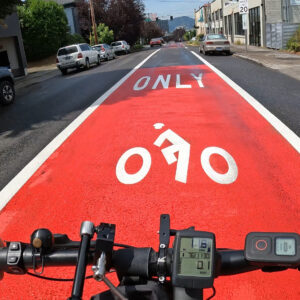

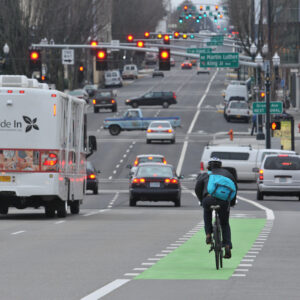

Thanks for reading.
BikePortland has served this community with independent community journalism since 2005. We rely on subscriptions from readers like you to survive. Your financial support is vital in keeping this valuable resource alive and well.
Please subscribe today to strengthen and expand our work.
This sounds like it should be pretty nice. I’m moving near here soon, so having some of these improvements will hopefully make Burnside a bit more accessible, both for crossing and as a destination. I have to say, it would have been awesome if they extended the bike lane up to 20th though.
So all traffic on southwestbound Sandy that wants to continue on sandy now has to go on Couch, then onto 12th St South, Cross Burnside and then continue on sandy. I wonder how much traffic that will be and how that will affect bikers. The timing of the lights should help us keep up with traffic which is a huge plus.
I really hope that their plans for Ankeny include fixing all the road hazards that the city has been creating there this summer. Whatever bureau has been digging up the street keeps filling their holes to just below grade, making for a crotch-punishing commute for Buckman residents.
I looked at the .PDF for the 2009 revised couplet plan on the project website and I can’t tell if there are any new bike corrals or racks planned for E. Burnside. How can I see what the bike parking plans are?
I hope it will be easier to find secured, high visibility/security parking.*
*In front of Union Jack’s
Speaking of parking, I thought of a great parking protest we could do on a street where they should remove the parking for the safety of all, but refuse to do so because of short-sighted business interests. What if we had a group of people stake out a block, and every time a parking space opens up, one person moves their bike square into the middle of the spot, and puts down the kickstand. Keep going until all the spaces are taken up …with one bike apiece. Use your jenkiest bike, because there might be some shenanigans done by the car people.
@ #5, la otra: Don’t antagonize, instead cooperate and you’ll get a lot further. As far as I know, parking spaces, at least timed or metered ones, are only for registered vehicles as a matter of accountability. Maybe instead try just nicely talking to the business owners and telling them bike parking is a consideration in deciding where you spend your money.
@ # 6: I wish that such cooperation made a real difference.
In nearly EVERY instance where I have tried to educate shop owners by asking them to improve bike parking and then explaining why, most of them told me it wasn’t important enough to spend the money on bike improvements, or that there weren’t enough bicyclists to make the improvements worthwhile.
A few have even told me that if I was riding a bike for transportation, that must mean I couldn’t possibly afford to spend as much as someone who afford a car, and therefore would not have as much of an impact on their bottom line.
There is a long, uphill battle to be waged here about myths and perecptions around who rides bikes for tranpsortation and how much economic impact they really have. Good luck.
“Ultimately, the decision was made to make room for the bike lane by narrowing the sidewalk from 12 to 7 feet.” maus/bikeportland
To make room for what? They might say they’re making room for the bike lane, but they’re actually making room for….on-street parking.
It doesn’t seem like a very good idea for the city to continue to cling to that type of parking, when it could be using the extra 5 feet for al fresco restaurant dining, bike racks or some other more productive purpose than parking cars.
The city makes a huge amount of money from parking. Some of that money should be going to help construct off-street parking including underground parking.
this project will do nothing for cyclists except ruin NW Couch for cycling; it is a motor vehicle ‘capacity enhancement’ project first and foremost, and no matter how PDOT dresses it up it’s still a pig with lipstick.
adding curb extensions is just another way to make the curbside parking permanent.
This is obviously a thinly veiled look at preparing these streets for future annoying streetcars.
This, coupled with their idea for future treatment of said roads downtown, has been announced as Sham’s plan.
May sound great now, until were are hopping sideways back and forth across tracks all the way in and out of downtown.
You can bet they will remove the parking for the streetcars though.
All in the name of progress, with new transportation options which are slower than walking…not to mention outrageously overpriced, outdated, and unneeded.
I’m not impressed with having bike lanes on Couch – it means that under most circumstances it won’t be legal to take the lane anymore – it would be better to leave the sidewalk 12′ (which is friendlier for pedestrians and makes the area more community-friendly) and to allow bikes to take the lane. Timid riders have a great alternative only 2 blocks away on Ankeny, or can ride on Davis.
I *do* approve of the bike lane on Burnside, which provides a safe space for cyclists climbing the rise towards 12th & Sandy.
In looking at this project from a bicyclist/motorist viewpoint, I wish that there was some way of accomidating below ground parking. The wide sidewalks encourage people to walk where they are going not drive.On street parking in this area is hazardous, for motorists and for bicycling public, and only benefits the surrounding business, how about parking off street, or further away and walking?. There is really nice wide sidewalks.
Exciting to see this moving forward!
I do call into question the need for on-street car parking on Couch.
On Burnside – totally understandable. But on Couch? Between SE 13th & SE 6th there’s what…. threeeee businesses? Maybe…. fouuuuuur?
Couch is a neighborhood residential street for the most part, with hardly any businesses on it! Seems a little silly to avoid striping a bikelane just to placate a handful of businesses.
But otherwise, exciting project!
clearly the idea is to redevelop Couch in such a way as to bring in new retail businesses. this stretch is not so much residential now (though there are a couple of apartment buildings, facing away from the street) as light industrial and warehouse, with almost zero foot traffic. the claim that they are subtracting sidewalk space to provide for a bike lane is extremely poor p.r. for “us,” and comment 8 is exactly correct in saying that the true purpose is to accommodate onstreet parking. again, and again, and again. the business about the “third rail” is nonsense (and weirdly ironic, as the third rail is conventionally used for commuter trains) where there are essentially no retail businesses already in place. and how exactly does closing Sandy between 12th and 14th affect cyclists, except by dumping more westbound traffic onto Couch? the existing six-way intersection is adequately regulated by signals.
oh, and where were the public hearings to determine that these bike lanes are “suitable” for purposes of 814.420?
I love how they pit pedestrians and cyclists against each other, fighting for scraps at the table. Sorry, Sam, call me cynical. One-way streets are not always bad news, but in this case, I vote FAIL.
A better solution all round would have been to put the Burnside Bridge on a “diet”…reducing it to two lanes each way (making space for an extra wide bike/ped promenade), and keeping East Burnside on a two lane each way diet. On street parking on Burnside is now surrendered for motor vehicle commuters in the peaks. This project keeps the three lanes for eastbound Burnside in keeping with PBOT’s actual vision for Portland…”keep motor vehicle traffic moving” and damn the residential and business community along the street. Look at the Broadway/Weidler “racetrack” as another example of this failure to walk the talk.
I actually don’t mind the three lanes one way deal, as I usually wouldn’t choose to ride up Burnside anyway further than I absolutely have to, and it seems to me that it will be easier to cross being three lanes in one direction than 4 lanes in two directions. Certainly, the city could have done more to accommodate bicycles in this project, but I don’t think it’s quite so negative. I do like the idea about the bridge itself though, especially for East-bound traffic, as the bridge is pretty steep on the West side.
What a surprise. The commenters here aren’t happy with something that the City of Portland is doing. Why am I not surprised.
re comment 19. because they are doing it wrong.